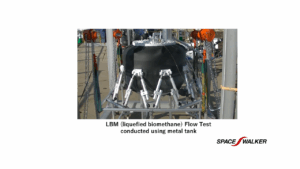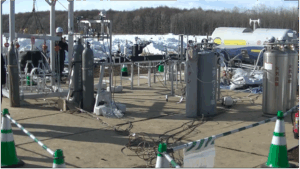Tokyo, Japan, February 28 – Space Walker conducted a liquefied biomethane (LBM) flow test, using a metal tank, as part of the technology development steps for the composite propellant tank planned for installation on the test rocket, which is planned for launch in 2026.

Overview of the LBM (Liquefied Biomethane) Propellant and the Flow Test
Space Walker is conducting research and validation to evaluate the suitability of LBM (liquefied biomethane) as a propellant for its spaceplane to enable rocket reusability and to reduce environmental impact through the use of clean fuel.
This project is being carried out as part of the New Energy and Industrial Technology Development Organization (NEDO) 2023 Deep Tech Startup Support Fund/SBIR Promotion Program (Phase 1: Project name: Technology development that contributes to industrial development and strengthening international competitiveness through private space activities; Theme name: Research into the suitability of LBMs for rocket fuel, demonstration, and feasibility of long-distance transport, and feasibility study on safety), which was adopted in 2023.

(Site photo of the flow test operation on the liquid biomethane test propellant tanks)

(Engineers conducting the test amid snow flurries)
Summary of the LBM (liquefied biomethane) Fuel Flow Test
Test purpose:
To acquire basic data on the pre-cooling/filling operations of the metal tank for LBM (liquefied biomethane) testing, as well as performance characteristic data for the tank pressurization and discharge sections, and to confirm suitability for the propulsion system with liquefied biomethane.
Test content: LBM filling test, LBM flow test
Test period: February 25th through 28th, 2025
Test site: Hokkaido Spaceport (Taiki town, Hiroo district, Hokkaido)
Test result:
The characteristic data of the tank pressurization pressure using helium gas and LBM flow rate were obtained, which are essential for application in the development of the test rocket’s liquefaction tank.
Division in charge: Space Transportation Division, SPACE WALKER
Cooperating companies:
Department of Mechanical and Aerospace Engineering, Faculty of Science and Technology, Tokyo University of Science
AIR WATER INDUSTRIAL AND MEDICAL GASES INC.
Further Development
Following the results of this test, we plan to proceed with testing using LBM (liquefied biomethane) and LOX (liquid oxygen) in the composite FM (flight model) propellant tank intended for actual use in the test rocket. Our goal is to complete development of a flame-resistant composite propellant tank for integration into the test rocket scheduled for launch in 2026.
We look forward to sharing further milestones as we move toward the future of space transport.
——————————————
【About SPACE WALKER】
Space Walker is a university startup conducting research and development of winged reusable suborbital and orbital spaceplanes. The company also develops key components and other related businesses, such as next-generation composite tanks—applying space technology to accelerate industrial decarbonization on Earth. Space Walker envisions sustainable space transportation for all, as familiar as commercial air travel today. For more information, please visit https://space-walker.co.jp/en
【For inquiries, contact】
Corporate Planning Office/Public Relations
pr@space-walker.co.jp

